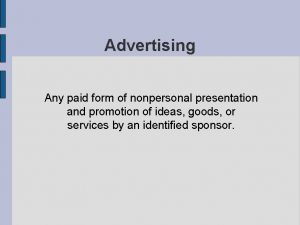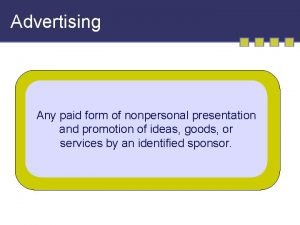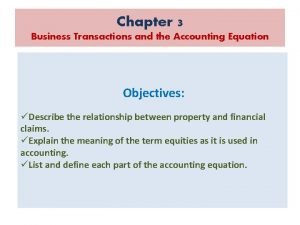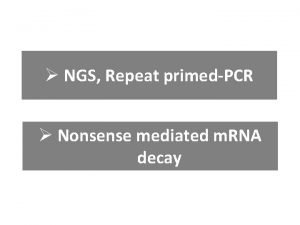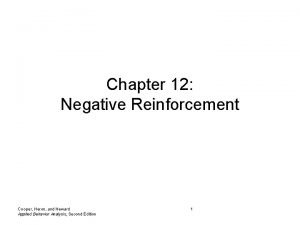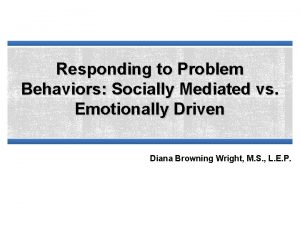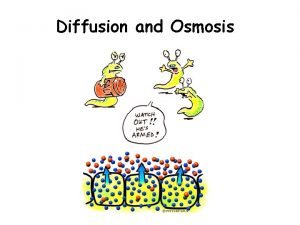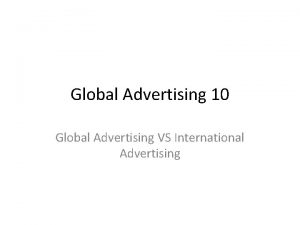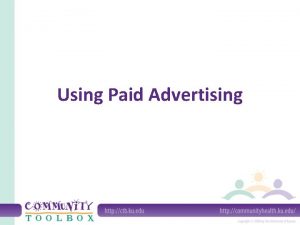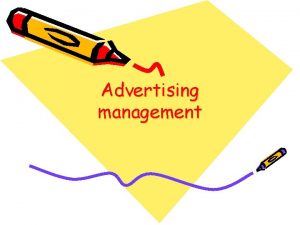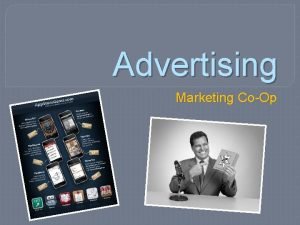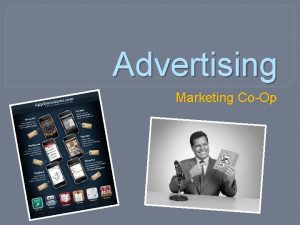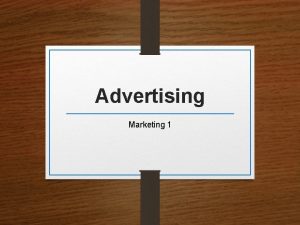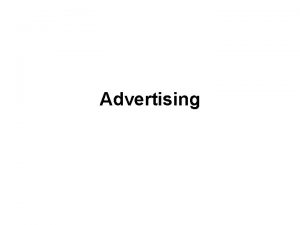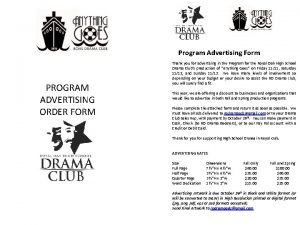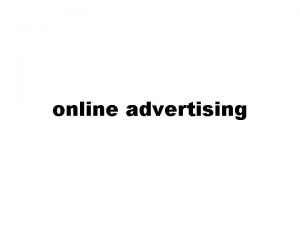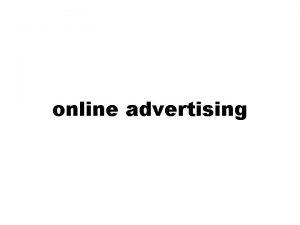Introduction Advertising Defined A paid mediated form of

























- Slides: 25

Introduction • Advertising Defined Ø A paid, mediated form of communication from an identifiable source, designed to persuade the receiver to take some action, now or in the future • Types of Advertising Ø Business to Consumer (B 2 C) Ø Business to Business (B 2 B) © 2010 South-Western, a part of Cengage Learning. All rights reserved. 7– 1

Figure 7. 1 Example of the Use of Humor in B 2 B Advertising © 2010 South-Western, a part of Cengage Learning. All rights reserved. 7– 2

The Magnitude of Advertising United States: $294 billion ($1, 000 person) © 2010 South-Western, a part of Cengage Learning. All rights reserved. Global: $360 billion 7– 3

Table 7. 1 Top 20 Spenders in U. S Advertising, 2006 ($ million) © 2010 South-Western, a part of Cengage Learning. All rights reserved. 7– 4

The Magnitude of Advertising (cont’d) • Advertising-to-Sales Ratios Ø Advertising as a percentage of sales ranges from a low of 1. 3 % to a high of 29. 9 % Ø Ratios typically range from 2% to 10% with an average of 3. 1% across most B 2 C and B 2 B categories Ø Competition from larger firms forces smaller companies to have higher ratios Ø Personal care products based on image have high ratios © 2010 South-Western, a part of Cengage Learning. All rights reserved. 7– 5

Table 7. 2 a Advertising-to-Sales Ratios for Select Product Categories © 2010 South-Western, a part of Cengage Learning. All rights reserved. 7– 6

Table 7. 2 b Advertising-to-Sales Ratios for Select Product Categories © 2010 South-Western, a part of Cengage Learning. All rights reserved. 7– 7

Table 7. 2 c Advertising-to-Sales Ratios for Select Product Categories © 2010 South-Western, a part of Cengage Learning. All rights reserved. 7– 8

The Magnitude of Advertising (cont’d) • Advertising Effects Are Uncertain Ø Advertising is not just a current expense but rather is an investment Ø Advertising should not be managed as a discretionary variable cost Ø Advertising should not be the first reduction when financial pressures call for cost-cutting measures. Ø Consistent investment spending is the key factor underlying successful advertising Ø Stopping advertising can cause a brand to lose market momentum, reducing its equity and market share © 2010 South-Western, a part of Cengage Learning. All rights reserved. 7– 9

Advertising Functions Informing Reminding and Increasing Salience Influencing Adding Value © 2010 South-Western, a part of Cengage Learning. All rights reserved. Assisting Other Company Efforts 7– 10

Advertising Functions • Informing Ø Making consumers aware of new brands. Ø Increasing TOMA (Top of Mind Awareness) Ø Teaching new uses for existing brands (called usage expansion advertising) v v v Campbell’s soup formal family dinners and for breakfast Special K for afternoon or late-night snacking Arm & Hammer baking soda as a deodorant for refrigerators • Influencing Ø Getting prospective customers to try advertised products and services: © 2010 South-Western, a part of Cengage Learning. All rights reserved. 7– 11

Advertising Functions (cont’d) • Reminding and Increasing Salience Ø Enriching the memory trace for a brand so that the brand comes to mind in relevant choice situations Ø Increasing customers’ interest in mature brands and the likelihood of choosing brands that might have otherwise not been chosen. Ø Influence brand switching by reminding consumers that the brand is available and that it possesses favorable attributes. © 2010 South-Western, a part of Cengage Learning. All rights reserved. 7– 12

Advertising Functions (cont’d) • Using Advertising to Assist Other Company Efforts Ø To deliver coupons and sweepstakes Ø To assist sales representatives Ø To pre-sell a firm’s products by introducing the product and legitimizing salespeople’s claims Ø To augment the effectiveness of price deals © 2010 South-Western, a part of Cengage Learning. All rights reserved. 7– 13

Figure 7. 2 The Advertising Management Process © 2010 South-Western, a part of Cengage Learning. All rights reserved. 7– 14

The Role of Advertising Agencies Advertising Function Alternatives In-house Advertising Operation Purchase Services As Needed © 2010 South-Western, a part of Cengage Learning. All rights reserved. Use a a Full-Service Advertising Agency 7– 15

Why Advertising Agencies 7– 16

Table 7. 3 Top-10 U. S. Advertising Agencies in Ad Revenue, 2006 © 2010 South-Western, a part of Cengage Learning. All rights reserved. 7– 17

Advertising Function Alternatives • In-House Advertising Operation Ø Necessitates employing an advertising staff and absorbing the operation costs Ø Unprofitable unless a company does a large amount of continual advertising © 2010 South-Western, a part of Cengage Learning. All rights reserved. 7– 18

Advertising Function Alternatives • Purchase Services À la Carte Ø Advantages v Use services only when they are needed v Availability of high-caliber creative talent v Potential cost efficiencies Ø Disadvantages v Lack cost accountability v Financial instability of smaller boutiques © 2010 South-Western, a part of Cengage Learning. All rights reserved. 7– 19

Advertising Function Alternatives • Full-Service Advertising Agency Ø Advantages v Access to in-depth knowledge and skills v Obtaining negotiating leverage with the media v Coordinating advertising and marketing efforts Ø Disadvantages v Some control of advertising function is lost v Larger clients are favored over small clients v Occasionally inefficient in media buying © 2010 South-Western, a part of Cengage Learning. All rights reserved. 7– 20

Advertising Agency Organization Creative Services • Develop advertising copy and campaigns • Copywriters, production people, and creative directors Media Services • Selecting the best advertising media • Media planners develop overall media strategy • Media buyers procure the selected media Research Services • Study clients’ customers’ buying habits, purchase preferences, and responsiveness • Focus groups, mall intercepts, acquisition of syndicated research data Account Management • Link the agency with the client • Act as liaisons so that the client does not need to interact directly with several different service departments and specialists © 2010 South-Western, a part of Cengage Learning. All rights reserved. 7– 21

Agency Compensation Methods Commissions from Media Labor-based Fee System © 2010 South-Western, a part of Cengage Learning. All rights reserved. Outcome- or Performance-based Programs 7– 22

Agency of Record • Divorce account management and creative from media • Creative agency gets 12. 5%; media agency gets 2. 5% • Makes sense when a client has many brands (e. g. P&G can split brands amongst agencies but combine all media spending under one media specialist buyer) • Client benefits from better media rates and favorable positions. © 2010 South-Western, a part of Cengage Learning. All rights reserved. 7– 23

Ad-Investment Considerations: Which Position Is More Acceptable? • The Case for Investing Ø Advertising can increase profitability by increasing sales volume, enabling higher selling prices, and thus increasing revenue beyond the incremental advertising expense. • The Case for Disinvesting Ø Firms choose to reduce advertising expenses either when a brand is performing well or during economic recession in the belief that an expense reduction, with all else held constant, will result in increased profits. © 2010 South-Western, a part of Cengage Learning. All rights reserved. 7– 24

Advertising versus Pricing Elasticity • Elasticity Ø A measure of how responsive the demand for a brand is to changes in marketing variables such as price and advertising • Calculating elasticity coefficients for price (EP) and advertising (EA): Ø EP = Percentage change in quantity demanded Percentage change in price Ø EA = Percentage change in quantity demanded Percentage change in advertising © 2010 South-Western, a part of Cengage Learning. All rights reserved. 7– 25
 Non-personal presentation
Non-personal presentation Any paid form of non personal promotion
Any paid form of non personal promotion Is a paid form of communication
Is a paid form of communication Problem 3-4 classifying accounts answer key
Problem 3-4 classifying accounts answer key A collection of well defined objects is called
A collection of well defined objects is called Carrier mediated transport
Carrier mediated transport Moderator vs mediator
Moderator vs mediator Receptor-mediated endocytosis
Receptor-mediated endocytosis Transcellular diffusion
Transcellular diffusion Humoral and cell mediated immunity difference
Humoral and cell mediated immunity difference Nonsense mediated decay
Nonsense mediated decay Negative reinforcement
Negative reinforcement Socially mediated positive
Socially mediated positive Receptor mediated endocytosis
Receptor mediated endocytosis Cell mediated immunity
Cell mediated immunity Cell mediated immunity
Cell mediated immunity Receptor - mediated endocytosis
Receptor - mediated endocytosis Mediated values essay examples
Mediated values essay examples Receptor - mediated endocytosis
Receptor - mediated endocytosis What transport is endocytosis
What transport is endocytosis Agrobacterium mediated gene transfer
Agrobacterium mediated gene transfer Receptor - mediated endocytosis
Receptor - mediated endocytosis Route of drug administration
Route of drug administration Nonsense mediated decay
Nonsense mediated decay Global advertising and international advertising
Global advertising and international advertising Softrock sdr
Softrock sdr
